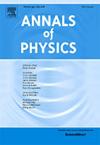在两个正交偏振的交叉高精细光学腔中加载玻色-爱因斯坦凝聚体中的量子相
IF 3
3区 物理与天体物理
Q2 PHYSICS, MULTIDISCIPLINARY
引用次数: 0
摘要
我们考虑了一个玻色-爱因斯坦凝聚体(BEC)通过原子的标量极化率和矢量极化率耦合到两个具有正交极化模式的交叉光学腔。我们确定了基态相图,并研究了不同条件下两个腔内超辐射阶参量和光子数的行为。在设定的参数下,我们发现系统可以容纳三个不同的相位:两个腔中没有光子的正常相位(NP),只有光子在腔1中的超辐射相位(SR1)和两个腔中都有光子的超辐射相位(SR12)。研究了两腔在不同失谐幅度下耦合角对相界的影响。我们发现耦合角强烈地改变了SR1和SR12之间的边界。特别是当耦合角为90°时,SR12的相位被完全抑制。本文章由计算机程序翻译,如有差异,请以英文原文为准。
Quantum phases in a Bose–Einstein condensate loaded in two crossed high-finesse optical cavities with orthogonal polarizations
We consider a Bose–Einstein condensate (BEC) coupled to two crossed optical cavities with orthogonal polarization modes via the scalar and vectorial polarizabilities of the atoms. We determine the ground-state phase diagram and investigate the behaviors of superradiant order parameters and the photon numbers in both cavities under various conditions. With the set parameters, we find that the system accommodates three distinct phases: a normal phase with no photons in both cavities (), a superradiant phase with photons only in cavity 1 () and a superradiant phase with photons in both cavities (). We explore the effects of the coupling angle on the phase boundaries under different magnitudes of cavity detuning in the two cavities. We find that the coupling angle strongly modifies the boundary between and . In particular, when the coupling angle is equal to , the phase of is completely suppressed.
求助全文
通过发布文献求助,成功后即可免费获取论文全文。
去求助
来源期刊

Annals of Physics
物理-物理:综合
CiteScore
5.30
自引率
3.30%
发文量
211
审稿时长
47 days
期刊介绍:
Annals of Physics presents original work in all areas of basic theoretic physics research. Ideas are developed and fully explored, and thorough treatment is given to first principles and ultimate applications. Annals of Physics emphasizes clarity and intelligibility in the articles it publishes, thus making them as accessible as possible. Readers familiar with recent developments in the field are provided with sufficient detail and background to follow the arguments and understand their significance.
The Editors of the journal cover all fields of theoretical physics. Articles published in the journal are typically longer than 20 pages.
 求助内容:
求助内容: 应助结果提醒方式:
应助结果提醒方式:


